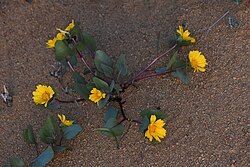Biology:Agnorhiza bolanderi
| Agnorhiza bolanderi | |
|---|---|

| |
| Scientific classification | |
| Kingdom: | Plantae |
| Clade: | Tracheophytes |
| Clade: | Angiosperms |
| Clade: | Eudicots |
| Clade: | Asterids |
| Order: | Asterales |
| Family: | Asteraceae |
| Genus: | Agnorhiza |
| Species: | A. bolanderi
|
| Binomial name | |
| Agnorhiza bolanderi (A.Gray) W.A.Weber
| |
| Synonyms[2] | |
| |
Agnorhiza bolanderi is a species of flowering plant known by the common name Bolander's mule's ears. It is endemic to California , where it is known only from a narrow section of the Sierra Nevada foothills about 275 kilometers long from Shasta County to Mariposa County.[3] It grows in chaparral and grassland habitat, usually on serpentine soils.[4][5]
Description
Agnorhiza bolanderi is a perennial herb growing from a thick taproot and caudex unit. This underground stem part helps it survive wildfire, which is common in its chaparral habitat.[3] The aboveground stem grows up to 30 centimeters long. It is glandular and sticky in texture. The leaves have oval blades up to 12 centimeters long. The inflorescence is a solitary bell-shaped, sunflower-like flower head sometimes tucked amongst the uppermost leaves. The head contains about 13 yellow ray florets which may be 2 to 3 centimeters long or more. At the center are yellow disc florets. The fruit is an achene about 7 millimeters long which does not have a pappus.[6][7]
The species is named for German-American botanist Henry Nicholas Bolander, 1831–1897.[8]
References
- ↑ "NatureServe Explorer - Agnorhiza bolanderi". NatureServe. 2022-05-30. https://explorer.natureserve.org/Taxon/ELEMENT_GLOBAL.2.156051.
- ↑ The Plant List, Agnorhiza bolanderi (A.Gray) W.A.Weber
- ↑ 3.0 3.1 Ayres, D. R. and F. J. Ryan. (1999). Genetic diversity and structure of the narrow endemic Wyethia reticulata and its congener W. bolanderi (Asteraceae) using RAPD and allozyme techniques. American Journal of Botany 86 344-53.
- ↑ Biota of North America Program 2014 county distribution map
- ↑ Calflora taxon report, Wyethia bolanderi (A. Gray) W.A. Weber Bolander wyethia, Bolander's mule ears, Bolander's wyethia
- ↑ Flora of North America, Vol. 21 Page 105, Agnorhiza bolanderi
- ↑ Jepson Manual Treatment
- ↑ Gray, Asa 1868. Proceedings of the American Academy of Arts and Sciences 7(2): 356 in English and Latin, as Balsamorhiza bolanderi
External links
- United States Department of Agriculture Plants Profile
- Calphotos Photo gallery, University of California
- Jepson Manual Treatment
Wikidata ☰ Q4693278 entry
 |


